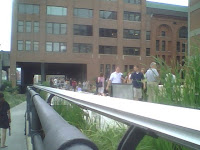

There's something thrilling just about walking up three flights to the High Line, New York's newest park. Usually, climbing stairs happens inside or is at least done to an enclosed destination, such as an elevated subway line. But not here. Everything is open; and when I entered, a breeze picked up, and I found my heart beating a little faster with anticipation, like when an amusement park ride reaches a scary moment.
Strangely enough, the High Line is a slightly intimidating park. It's a bit out of the way-- it now starts at the intersection of Gansevoort and Washington streets and heads north to 20th Street and 10th Avenue; eventually, it will reach 34rd Street. It takes some background knowledge to know where the entrances are -- unlike, say Central Park, with its large and open arms -- suggesting a nightclub rather than park. It's downtown, meaning there are many more well-dressed hipsters walking the trail than you find at other parks (though there are families and tourists too). It's publicly owned, but was a chic philanthropic cause among New York's finance and media circles. (Barry Diller and his wife, Diane von Furstenberg, and Philip Falcone and his wife are the two biggest donors. The largest amount of staff is in the fundraising department.) It has its own sleek logo.
So what. Everything else about the trail more than overcomes this. The benches, which rise out of the ground as cantilevered stone and wood, and grass stalks, some of which poke out of slits in the walkway as though they're weeds, are playful without being annoyingly cheeky. There are a surprising number of nooks for something not terribly wide or long, so you don't believe you've experienced the whole thing after one walk. The faux-beach, wooden lounge chairs are a great play on city sitting options, a small part of what makes the High Line so much fun: Its ability to mix settings and the noisily urban and the quietly private over and over again.
Obviously, the High Line is a park, so it's removed from the general froth of every Manhattan block. But it's also only three stories above the street -- not in its own separate area -- so New York, the country's most vertical city, keeps happening around you every step of the away. Fashion billboards are at eye level. Cabs, restaurants, living rooms and cubicles are within view. But then there are the grasses and other vegetation not found anywhere else in the city. Then there are the benches and chairs, where you can sit, quietly converse and relax. And it's a trail, meaning people are leisurely walking, rather than rushing past. (I was there on a cloudy Saturday morning, so perhaps in attractive weather, the High Line is thronged and annoying.) But then there's all the people-watching, a defining feature of city life. There are even depressed bleachers with a wall consisting of a glass pane at the bottom, which don't seem to have any function except to allow you to watch others.
The High Line is never static; your experience constantly shifts under your feet. It provides that most alluring of perspectives -- "What does this street look like 30 feet higher?" It never allows you to be fully at ease, which is perhaps what an urban park should be.
(Photos are my own; taken via cell phone.)
Update: Serge Kovalevski, in yesterday's Times, throws a little, deserved jab at the High Line, questioning the salary and consulting fees it pays its foundation's president while the organization seeks to fund the park partially via a neighborhood improvement district. Why is the story deserved even when it's premise is thinner than similar ones usually are? Because everyone's cage should be rattled once in awhile.
No comments:
Post a Comment